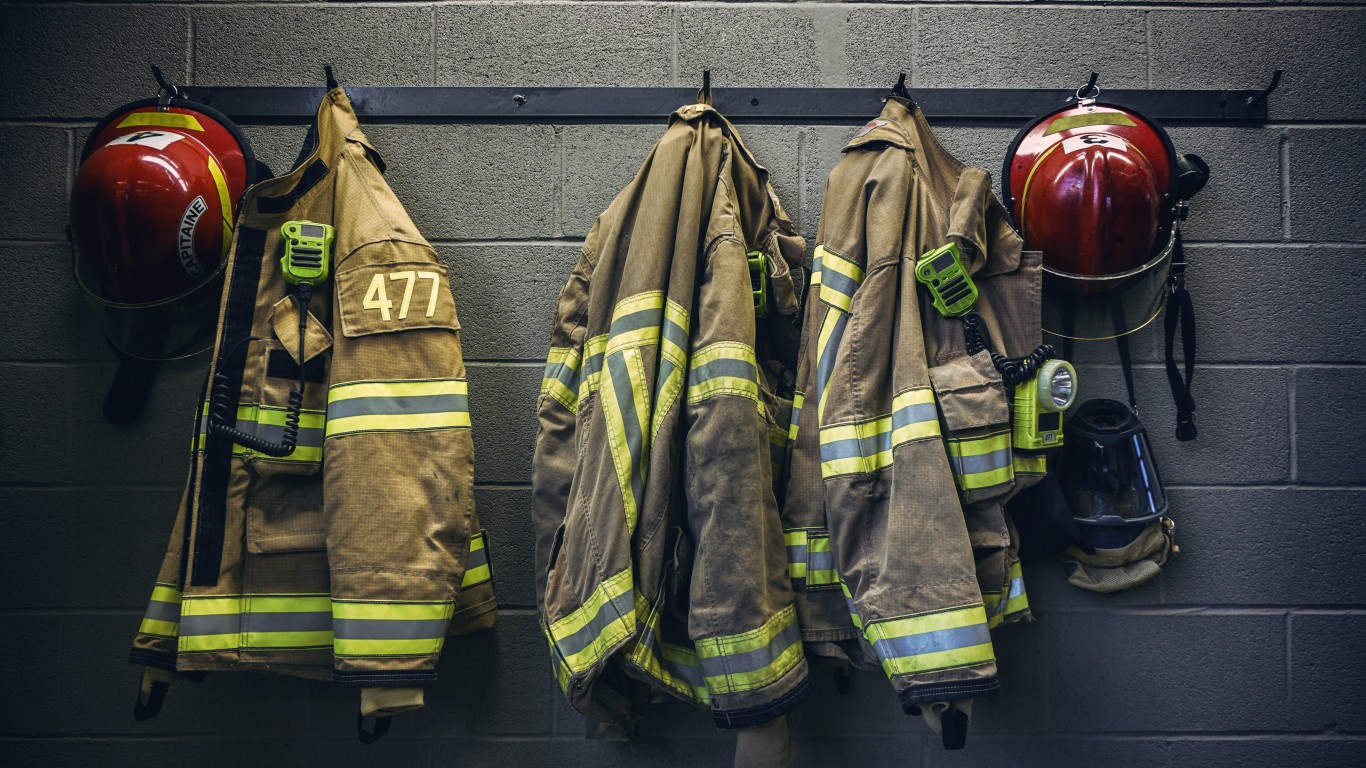
The typical American working full time — often defined as at least 35 to 40 hours a week — earns about $47,684 a year. However, there are several common jobs held by millions of Americans where the annual compensation is about half that amount.
Using median wage data from the Bureau of Labor Statistics, 24/7 Wall St. identified the 25 lowest-paying jobs in America. The rankings are based on 2019 median weekly earnings for full-time wage and salary workers by detailed occupation, multiplied by 52. Median earnings by gender, total employment by occupation, 10-year employment growth projections, and educational attainment by occupation also came from the BLS.
Many higher-paying jobs are typically those that require greater specialization and higher levels of educational attainment. Meanwhile, occupations with lower wages often only require some on-the-job training and do not have any formal education requirements. In every job on this list, the share of workers 25 and older with a bachelor’s degree is far below the 37.6% share of all workers in the labor force with a degree.
The vast majority of the lowest paying jobs in the United States are held by women. Additionally, in nearly every job on this list, the average earnings among female workers is lower than average earnings among men.
Still, not all high-paying jobs require a college education. Here is a look at the highest-paying jobs you can get without a college degree.
Due in large part to increased reliance on automation, many manual labor jobs will start becoming less common in the coming years. Still, overall employment is projected to climb over the decade between 2018 and 2028 in all but a handful of occupations on this list, according to the BLS. In the majority of these jobs, demand for workers is projected to increase faster than the 5.2% projected employment growth across all industries. Many of these occupations are in food service and health care. Here is a look at the jobs with the best job security.
Click here to see the 25 lowest paying jobs in America
Click here to see the 25 highest paying jobs in America

25. Misc. personal appearance workers
> Median annual earnings: $29,692
> Total number of workers: 227,000
> Projected employment change 2018-2028 10.2%
> Misc. personal appearance workers with a bachelor’s degree: N/A
The majority of Americans who fall into the miscellaneous personal appearance workers — a category which includes manicurists — are making less than $30,000 a year. Though the industry is dominated by women — over 85% of personal appearance workers are female — women in the job earn slightly less than their male counterparts. The median annual earnings among women in the job is about $1,000 below the median earnings among all workers.
[in-text-ad]

24. Hairdressers, hairstylists, and cosmetologists
> Median annual earnings: $29,640
> Total number of workers: 310,000
> Projected employment change 2018-2028 8.5%
> Hairdressers, hairstylists, and cosmetologists with a bachelor’s degree: 7.0%
The typical American working full time as a hairdresser, hairstylist, or cosmetologist earns $29,640 a year, well below the median earnings of $47,684 among all full-time workers. Like many of the jobs on this list, a bachelor’s degree is not a requirement, and only 7% have a four-year college degree. Still, Nearly 94% of hairdressers, hairstylists, and cosmetologists have a high school diploma, and many obtain an associate’s degree in cosmetology.

23. Graders and sorters, agricultural products
> Median annual earnings: $29,328
> Total number of workers: 78,000
> Projected employment change 2018-2028 -1.5%
> Graders and sorters, agricultural products with a bachelor’s degree: 3.7%
Agricultural workers who grade and sort unprocessed produce are some of the lowest paid workers in the United States, with a median annual salary of $29,328. Like many jobs on this list, typically there are no formal educational prerequisites for these jobs, though most graders and sorters of agricultural products have some short-term on-the-job training.
Not only are jobs in this field low paying, but also they are not especially secure. In over roughly the next decade, total employment in the occupation is projected to fall by 1.5%.

22. Nursing, psychiatric, and home health aides
> Median annual earnings: $29,224
> Total number of workers: 1.5 million
> Projected employment change 2018-2028 18.3%
> Nursing, psychiatric, and home health aides with a bachelor’s degree: N/A
While many jobs in the health care industry pay high salaries, positions as nursing, psychiatric, and home health aides are often notable exceptions. As the job title suggests, people working in these jobs serve as aides or assistants to nurses, psychiatrists, and health workers who make home visits.
As is the case with many low paying jobs, demand for nursing, psychiatric, and home health aides is projected to spike by 18.3% over the decade ending with 2028. Employment growth is largely attributable to the aging population and the increased need for health care services.
[in-text-ad-2]

21. Bakers
> Median annual earnings: $29,172 (tied)
> Total number of workers: 151,000
> Projected employment change 2018-2028 5.8%
> Bakers with a bachelor’s degree: 12.0%
Baking is one of a relatively small number of jobs in the United States where the majority of workers earn less than $30,000 a year. Bakers can work in a broad range of environments, including grocery stores, restaurants, and commercial bakeries. While there are typically no formal educational attainment requirements to become a baker, most people working in the profession have had long-term on-the-job training.

20. Parking lot attendants
> Median annual earnings: $29,172 (tied)
> Total number of workers: 58,000
> Projected employment change 2018-2028 0.1%
> Parking lot attendants with a bachelor’s degree: 13.1%
Parking lot attendants are some of the lowest paid workers in the United States, earning a median annual salary of just $29,172. As is often the case among the jobs on this list, no formal education is necessary to becoming a parking lot attendant. In fact, about one in every five parking lot attendants age 25 and up do not have a high school diploma.
[in-text-ad]

19. Misc. agricultural workers
> Median annual earnings: $29,016
> Total number of workers: 691,000
> Projected employment change 2018-2028 1.2%
> Misc. agricultural workers with a bachelor’s degree: N/A
Miscellaneous agricultural workers is a broad occupational category that includes farm equipment operators, laborers, and greenhouse workers. The typical miscellaneous agricultural worker earns just $29,016 per year, nearly $19,000 less than the typical American worker.
The gender pay gap in the miscellaneous agricultural work is smaller than it is in most jobs, with women earning about 86.4% of what their male counterparts earn. Across all occupations, women earn 81.5% as much as men do.

18. Dining room and cafeteria attendants and bartender helpers
> Median annual earnings: $28,808
> Total number of workers: 116,000
> Projected employment change 2018-2028 9.7%
> Dining room and cafeteria attendants and bartender helpers with a bachelor’s degree: 8.7%
Dining room and cafeteria attendants and bartender helpers are one of only 18 occupational categories in the U.S. where a person working full time makes less than $29,000 a year. Like most low-paying jobs, there are no formal education requirements for cafeteria attendants and barbacks. Just 8.7% of adults working these jobs have a bachelor’s degree or higher.

17. Packers and packagers, hand
> Median annual earnings: $27,560
> Total number of workers: 467,000
> Projected employment change 2018-2028 -3.5%
> Packers and packagers, hand with a bachelor’s degree: 5.8%
Hand packers and packagers can have a wide range of responsibilities, including loading materials into package processing equipment, measuring and weighing materials, and recording details of shipments and deliveries. One of the lowest-paying professions in the U.S., most Americans working full time as packers and packagers earn less than $28,000 a year.
Not only is the job low paying, but it will also likely be less secure in the coming years. The BLS projects total employment in the occupation to decline by 3.5% between 2018 and 2028.
[in-text-ad-2]

16. Sewing machine operators
> Median annual earnings: $27,248
> Total number of workers: 138,000
> Projected employment change 2018-2028 -11.9%
> Sewing machine operators with a bachelor’s degree: 7.1%
Sewing machine operators is an occupational classification that includes tailors and seamstresses and other workers in textile operations. While the job requires precision control and manual dexterity, there are typically no formal education requirements. Like many jobs that do not require a college degree, sewing machine operators are not paid much. The median annual wage for the job of $27,248 is about $20,000 less than the median wage across all occupations.
According to the BLS, demand for sewing machine operators is projected to decline by nearly 12% between 2018 and 2028, likely due in part to improvements in automation.

15. Hotel, motel, and resort desk clerks
> Median annual earnings: $26,988
> Total number of workers: 90,000
> Projected employment change 2018-2028 -6.3%
> Hotel, motel, and resort desk clerks with a bachelor’s degree: 20.0%
The median annual income for hotel, motel, and resort desk clerks is just under $27,000. For context, the typical American working full time earns an estimated $47,684 annually. Not only is the job one of the lowest paying in the country, it is also one of the fastest disappearing. The BLS projects that over the decade between 2018 and 2028, the number of Americans working in such jobs will fall by 6.3% while total employment across all jobs is expected to increase by 5.2%.
[in-text-ad]

14. Automotive and watercraft service attendants
> Median annual earnings: $26,936
> Total number of workers: 67,000
> Projected employment change 2018-2028 4.9%
> Automotive and watercraft service attendants with a bachelor’s degree: 7.6%
Automotive and watercraft service attendants work in places like gas stations and docks and are typically responsible for tasks like filling fuel tanks, checking tire pressure and vehicle fluid levels, and making minor repairs. The job is one of only 15 in the United States where full-time workers earn less than $27,000 a year. There is typically no formal education requirement for workers in the occupation.

13. Personal care aides
> Median annual earnings: $26,832
> Total number of workers: 815,000
> Projected employment change 2018-2028 36.4%
> Personal care aides with a bachelor’s degree: 13.6%
Personal care aides help the eldery and people with disabilities with their daily living activities. Though the job ranks among the lowest paying in the country, with a median annual salary of just $26,832, demand for these workers is expected to spike in the coming years. The BLS projects employment of personal care aides to climb by 36.4% between 2018 and 2028, largely due to the aging baby boom generation. Meanwhile, overall employment across all occupations is expected to climb by only about 5% over the same period.

12. Food servers, non-restaurant
> Median annual earnings: $26,780 (tied)
> Total number of workers: 89,000
> Projected employment change 2018-2028 7.6%
> Food servers, non-restaurant with a bachelor’s degree: 9.1%
Non-restaurant food servers can work in any number of environments, including hospitals, residential care facilities, or hotels. The typical food server who does not work in a restaurant earns only $26,780 a year, about $21,000 less than the typical full-time worker in the U.S. Like most low-paying jobs, non-restaurant food service work does not typically require any formal education. Fewer than one in every 10 Americans working in the occupation have a bachelor’s degree.
[in-text-ad-2]
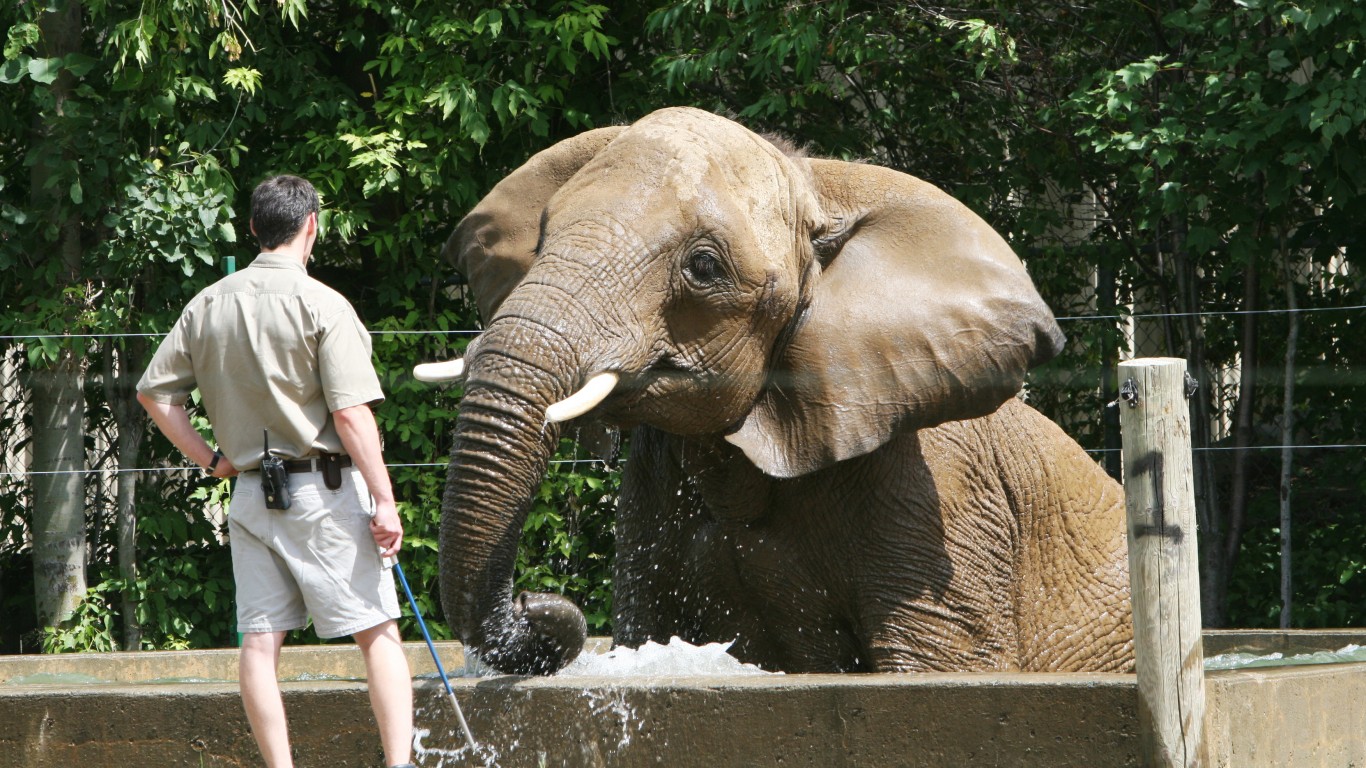
11. Nonfarm animal caretakers
> Median annual earnings: $26,780 (tied)
> Total number of workers: 105,000
> Projected employment change 2018-2028 16.0%
> Nonfarm animal caretakers with a bachelor’s degree: 21.9%
Nonfarm animal caretakers typically bathe, feed, and exercise different animals in places like kennels, zoos, and shelters. The median annual wage in the job is just $26,780, less than all but 10 other occupations.
While most jobs in this field only require a high school diploma, 21.9% of American adults working as nonfarm animal caretakers have a bachelor’s degree, the highest bachelor’s degree attainment rate of any job on this list.
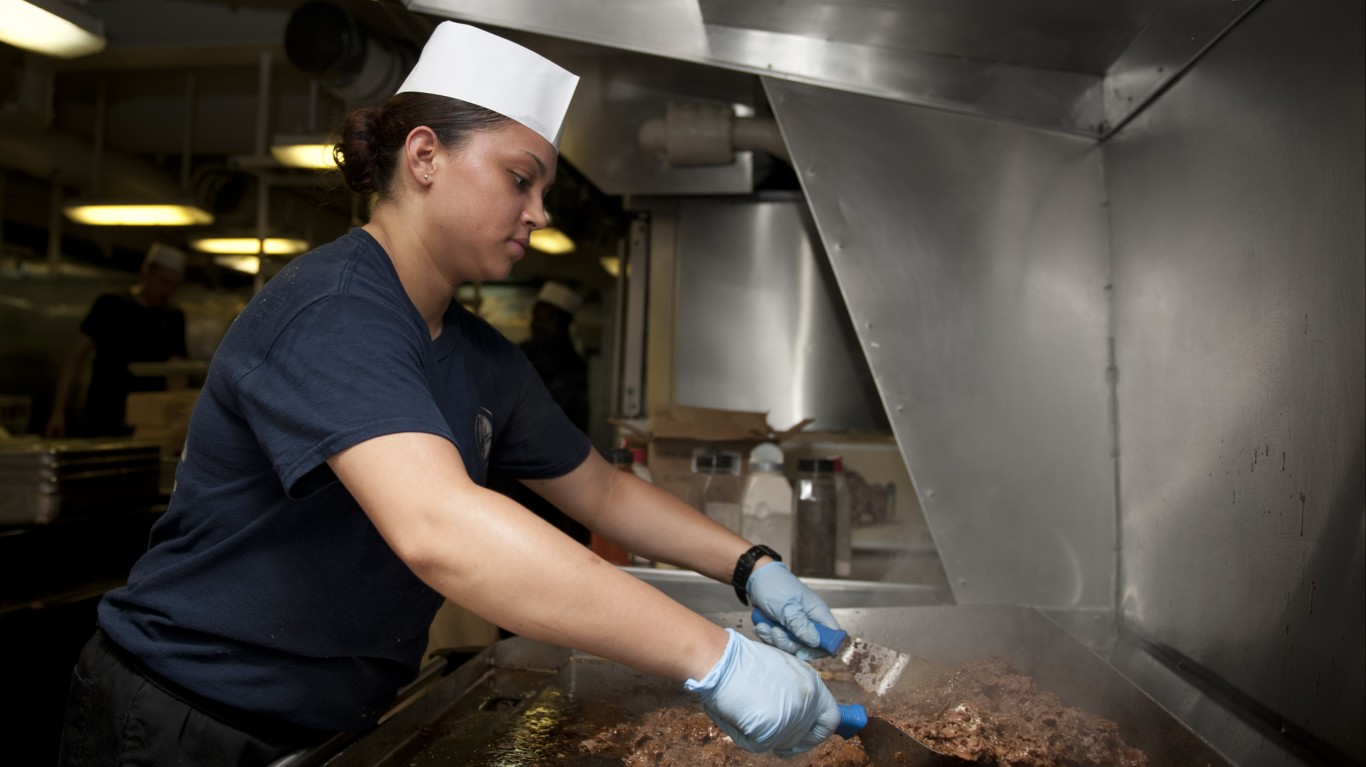
10. Cooks
> Median annual earnings: $26,624
> Total number of workers: 1.4 million
> Projected employment change 2018-2028 11.3%
> Cooks with a bachelor’s degree: N/A
Cooks can work in any number of environments, including restaurants, schools, hospitals, and even private households. While there is a wide range of salaries for cooks, depending on where they work, the median annual salary among all cooks working full time is just $26,624.
The gender pay gap among cooks is less than in most other professions. Women working as cooks earn about 90 cents for every dollar men earn. Meanwhile, across all occupations, women earn about 80 cents for every dollar men earn. About 61% of all cooks are men.
[in-text-ad]

9. Waiters and waitresses
> Median annual earnings: $26,572
> Total number of workers: 973,000
> Projected employment change 2018-2028 6.5%
> Waiters and waitresses with a bachelor’s degree: 15.8%
Waiters and waitresses earn just $26,572 a year, about $21,000 less than the annual salary of the typical full-time American worker. While waiters and waitresses have a lower median salary than nearly every other occupation, customer tips likely contribute to higher incomes for many in the field.
About 70% of all waiters and waitresses are women. The industry has a considerable gender pay gap, with women earning about 83 cents for every dollar men earn.

8. Cashiers
> Median annual earnings: $26,156
> Total number of workers: 1.4 million
> Projected employment change 2018-2028 -3.8%
> Cashiers with a bachelor’s degree: 11.8%
The median annual income for full-time cashiers in the U.S. is just $26,156. Technological advances will also make the job less common in the coming years. As more retailers use self-service checkout stands, the number of Americans working as cashiers is projected to decline by 3.8% between 2018 and 2028.
Cashiers have one of the smallest gender pay gaps of any occupation, with women earning 97.8% of what men do. Across all occupations, women earn just 81.5% of what men do.
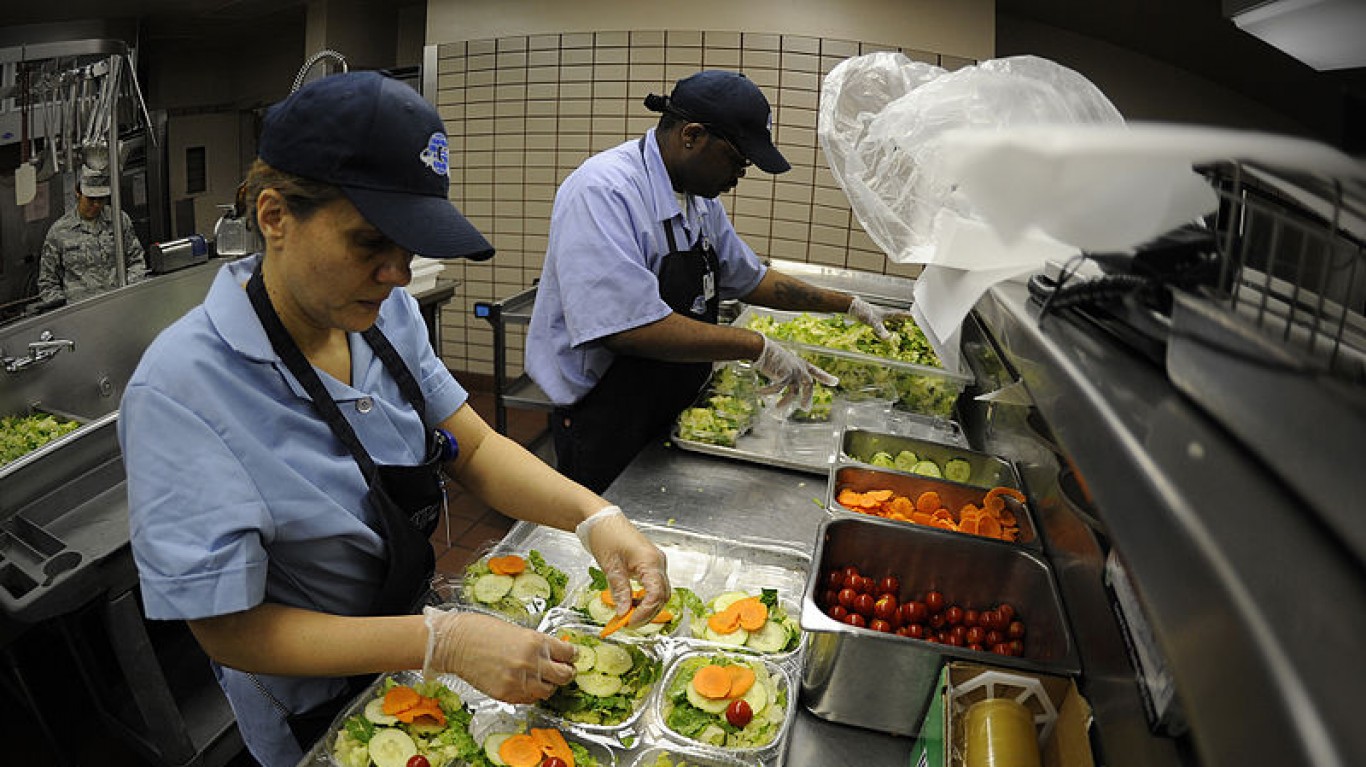
7. Food preparation workers
> Median annual earnings: $25,792
> Total number of workers: 574,000
> Projected employment change 2018-2028 8.2%
> Food preparation workers with a bachelor’s degree: 10.7%
Americans in food preparation work under cooks and chefs doing routine tasks like slicing meat and peeling and cutting vegetables. These jobs exist almost everywhere food is served, including places like hotels, restaurants, grocery stores, and cafeterias. Food preparation is one of only seven jobs in the United States where the majority of workers earn less than $26,000 a year.
[in-text-ad-2]

6. Childcare workers
> Median annual earnings: $25,740
> Total number of workers: 473,000
> Projected employment change 2018-2028 2.4%
> Childcare workers with a bachelor’s degree: 19.1%
Childcare workers — a group that is more than 90% women — can work in a range of environments, from daycare centers to private residences. While the median annual wage among child care workers is $25,740, pay can vary substantially, often with better-educated workers earning higher wages. An estimated 19.1% of adult child care workers in the U.S. have a bachelor’s degree or higher.

5. Maids and housekeeping cleaners
> Median annual earnings: $25,480 (tied)
> Total number of workers: 895,000
> Projected employment change 2018-2028 -1.7%
> Maids and housekeeping cleaners with a bachelor’s degree: 5.5%
Maids and housekeeping cleaners work in a range of environments, from private households to commercial establishments such as hotels or hospitals. The occupation typically has no formal education requirements and may only require some short on-the-job training. Only 5.5% of maids and housekeepers have a bachelor’s degree, and fewer than two-thirds have a high school diploma. The median annual salary for the job is just $25,480.
[in-text-ad]

4. Laundry and dry-cleaning workers
> Median annual earnings: $25,480 (tied)
> Total number of workers: 112,000
> Projected employment change 2018-2028 -0.5%
> Laundry and dry-cleaning workers with a bachelor’s degree: 4.5%
With a median annual income of $25,480, laundry and dry-cleaning is one of the lowest paying jobs in the U.S. Like most other low-paying jobs, there are no formal education prerequisites to becoming a laundry and dry-cleaning worker. Just 4.5% of laundry and dry-cleaning workers have a bachelor’s degree, and fewer than two-thirds have a high school diploma.

3. Combined food preparation and serving workers, including fast food
> Median annual earnings: $24,024
> Total number of workers: 191,000
> Projected employment change 2018-2028 17.3%
> Combined food preparation and serving workers, including fast food with a bachelor’s degree: 7.3%
Combined food preparation and serving workers, including fast food, are some of the lowest-paid workers in the labor force. The occupation is one of only three in the U.S. where someone working full time earns less than $25,000 a year. While some workers in this occupation receive customer tips, most rely exclusively on their hourly wage.
Americans are dining out more and more, and the number of fast food and fast casual restaurants in the United States is projected to grow in the coming years — and with it demand for such workers. The number of Americans working as combined food preparation and serving workers is projected to climb by 17.3% between 2018 and 2028.

2. Hosts and hostesses, restaurant, lounge, and coffee shop
> Median annual earnings: $23,712
> Total number of workers: 81,000
> Projected employment change 2018-2028 11.1%
> Hosts and hostesses, restaurant, lounge, and coffee shop with a bachelor’s degree: 20.6%
The typical host or hostess at a restaurant, lounge, or coffee shop earns $23,712 a year, about half as much as the typical American working full time does. The job, which typically entails welcoming patrons and showing them to their seat, has no formal education requirements and only short-term on the job training. Still, more than one in every five hosts and hostesses in the United States have a bachelor’s degree, a larger share than nearly every occupation on this list.
[in-text-ad-2]
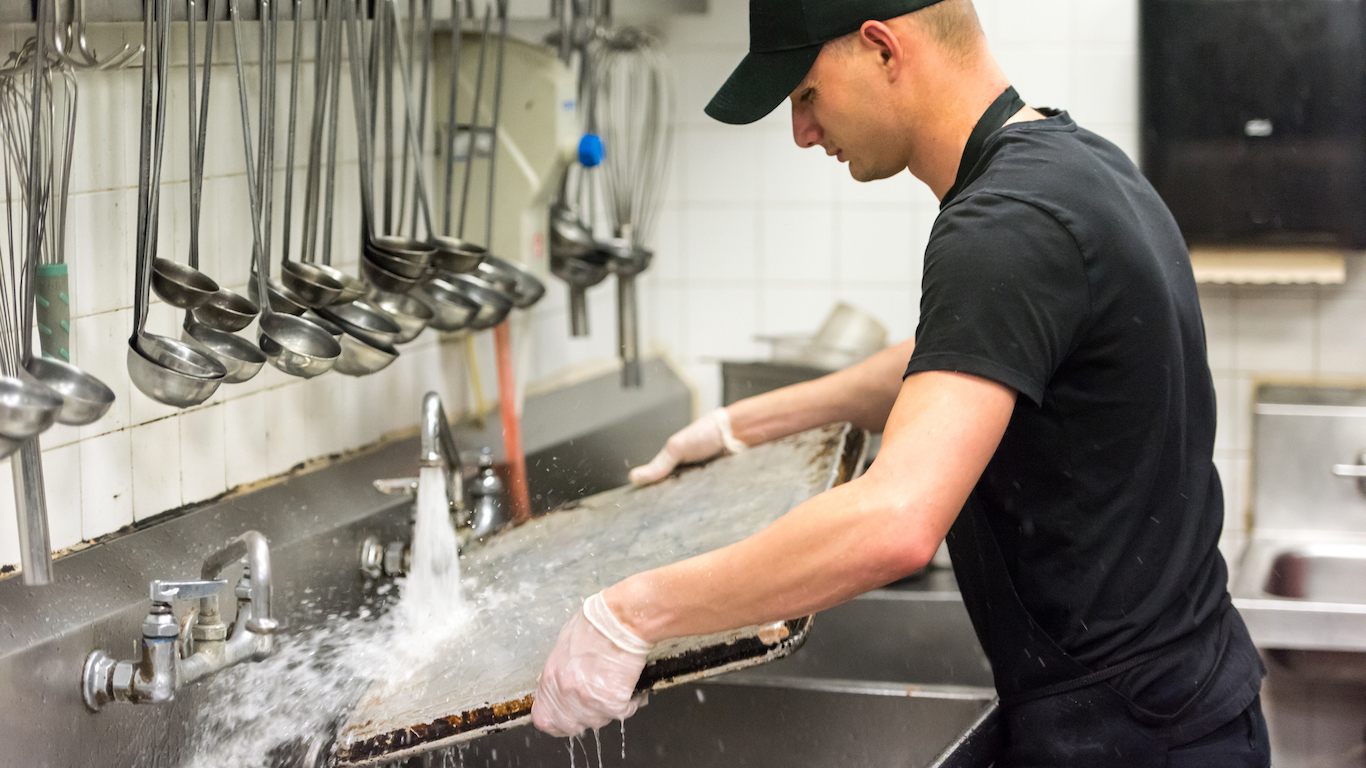
1. Dishwashers
> Median annual earnings: $23,556
> Total number of workers: 126,000
> Projected employment change 2018-2028 3.3%
> Dishwashers with a bachelor’s degree: 4.0%
Dishwashing is the lowest paying job in the United States. The typical American working full time as a dishwasher earns just $23,556 a year, about half the median income of $47,684 across all full-time workers. The job has no formal education requirements and only requires short-term training. Only 60% of Americans 25 and older working as dishwashers have a high school diploma, nearly the smallest share of any occupation on this list.
100 Million Americans Are Missing This Crucial Retirement Tool
The thought of burdening your family with a financial disaster is most Americans’ nightmare. However, recent studies show that over 100 million Americans still don’t have proper life insurance in the event they pass away.
Life insurance can bring peace of mind – ensuring your loved ones are safeguarded against unforeseen expenses and debts. With premiums often lower than expected and a variety of plans tailored to different life stages and health conditions, securing a policy is more accessible than ever.
A quick, no-obligation quote can provide valuable insight into what’s available and what might best suit your family’s needs. Life insurance is a simple step you can take today to help secure peace of mind for your loved ones tomorrow.
Click here to learn how to get a quote in just a few minutes.
Thank you for reading! Have some feedback for us?
Contact the 24/7 Wall St. editorial team.
 24/7 Wall St.
24/7 Wall St. 24/7 Wall St.
24/7 Wall St. 24/7 Wall St.
24/7 Wall St.

